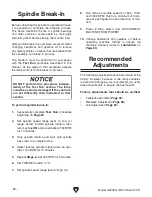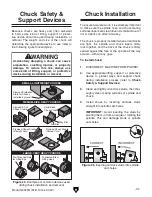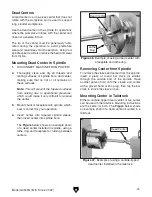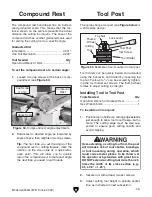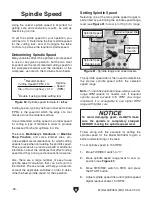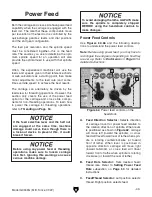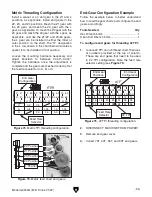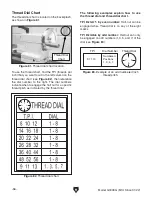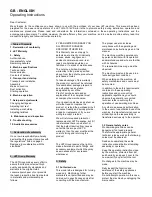
Model G0949G (Mfd. Since 01/22)
-41-
A dead center is a one-piece center that does not
rotate with the workpiece and is used to support
long, slender workpieces.
Use the dead center in the spindle for operations
where the workpiece rotates with the center and
does not generate friction.
The tip of the center must be generously lubri-
cated during the operation to avoid premature
wear and maximize smooth operation. Using low
spindle speeds will also reduce the heat and wear
from friction.
Dead Centers
Figure 46. Example of using a dead center with
a faceplate and lathe dog.
Dead Center
Lathe
Dog
1. DISCONNECT MACHINE FROM POWER!
2. Thoroughly clean and dry all threads and
mating surfaces of spindle bore and center,
making sure that no lint or oil remains on
these surfaces.
Note: This will prevent the tapered surfaces
from seizing due to operational pressures,
which could make it very difficult to remove
the center.
3. Mount chuck or faceplate onto spindle, which-
ever is correct for your operation.
4. Insert center into tapered spindle sleeve,
then insert center into spindle bore.
The
Figure below shows an example photo
of a dead center installed in spindle, using a
lathe dog and faceplate for turning between
centers.
Mounting Dead Center in Spindle
Removing Center from Spindle
To remove the sleeve and center from the spindle,
insert a piece of round bar stock (or similar)
through the outside end of the spindle. Have
another person hold onto the sleeve and center
with a gloved hand or shop rag, then tap the bar
stock to knock the sleeve loose.
Mounting Center in Tailstock
Either a carbide-tipped dead center or live center
can be used in the tailstock. Mounting instructions
are the same for both. The
Figure below shows
an example photo of a dead center mounted in a
tailstock.
Dead Center
Figure 47. Example of using a carbide-tipped
dead center installed in the tailstock.
Summary of Contents for G0949G
Page 108: ......


